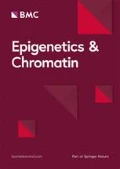Eukaryotic transcription factors (TFs) regulate gene expression by interacting with chromatinized DNA response elements (REs). Access to these elements is dramatically restricted by chromatin organization, and modification of the nucleoprotein structure to allow factor binding is emerging as a key feature of cell selective gene regulation [1–4]. These processes are highly dynamic, often with oscillatory or cyclical components operating on multiple time scales. Furthermore, many regulatory elements are located at great distance from target genes; long range interactions must play a significant, possibly dominant, role in gene regulation [5, 6]. We will discuss an integrated dynamic model for regulatory element function on multiple scales.
References
Biddie : . Moecular Cell. 2011, 43: 145-155.
Siersbaek : . EMBO J. 2011, 30: 1459-1472. 10.1038/emboj.2011.65.
Voss : . Cell. 2011, 146: 544-554. 10.1016/j.cell.2011.07.006.
Grontved : . Epigenetics Chromatin. 2012, 5: 1-12. 10.1186/1756-8935-5-1.
Hakim : . Genome Res. 2011, 21: 697-706. 10.1101/gr.111153.110.
Hakim : . Genome Res. 2011, 23 (Jan 22).
Author information
Authors and Affiliations
Rights and permissions
This article is published under license to BioMed Central Ltd. This is an Open Access article distributed under the terms of the Creative Commons Attribution License (http://creativecommons.org/licenses/by/2.0), which permits unrestricted use, distribution, and reproduction in any medium, provided the original work is properly cited.
About this article
Cite this article
Hager, G.L. Reprogramming the chromain landscape at eukaryotic regulatory elements. Epigenetics & Chromatin 6 (Suppl 1), O20 (2013). https://doi.org/10.1186/1756-8935-6-S1-O20
Published:
DOI: https://doi.org/10.1186/1756-8935-6-S1-O20

